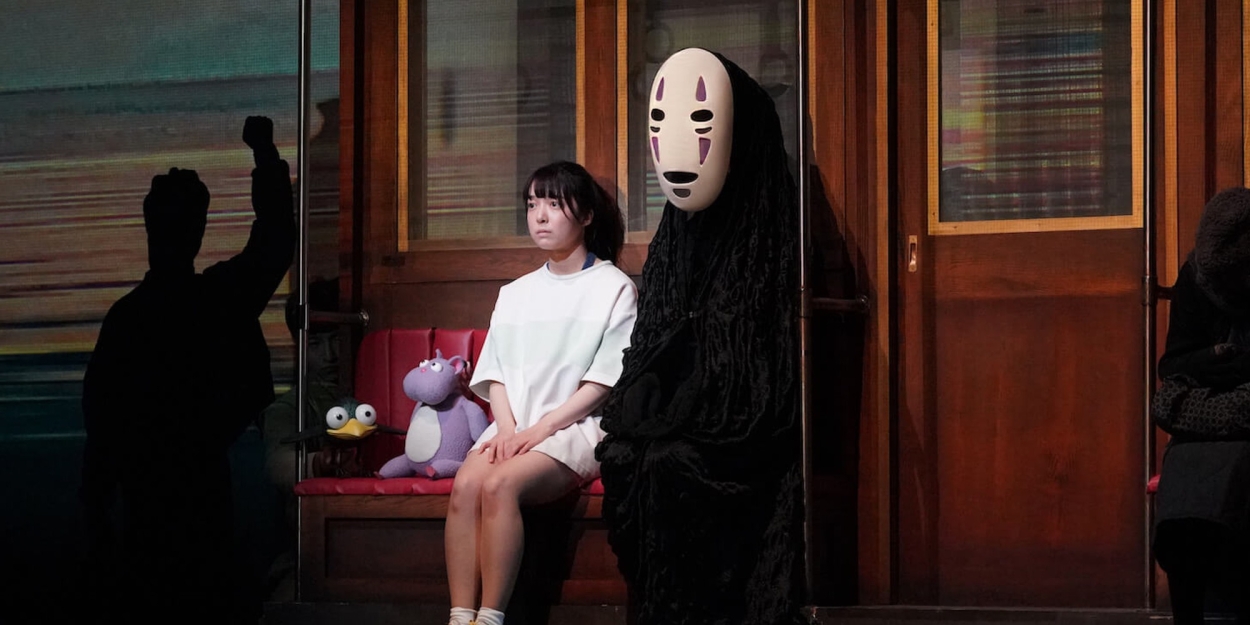Review: SPIRITED AWAY, London Coliseum
The blockbuster Japanese production lands in London.

![]() Hayao Miyazaki’s legacy is one for the ages. The co-founder of Studio Ghibli revolutionised the Western consumption of anime and set a new standard for Japanese animated films. London isn’t a stranger to the stage adaptations of his creations: a major example is My Neighbour Totoro, which took up shop at the Barbican to great acclaim last year and has already announced a West End run for next year.
Hayao Miyazaki’s legacy is one for the ages. The co-founder of Studio Ghibli revolutionised the Western consumption of anime and set a new standard for Japanese animated films. London isn’t a stranger to the stage adaptations of his creations: a major example is My Neighbour Totoro, which took up shop at the Barbican to great acclaim last year and has already announced a West End run for next year.
Theatre projects based on popular Asian media have been garnering excellent success recently, with manga-turned-anime-turned-musicals Death Note and Your Lie in April both receiving stellar reviews and steady audience support, so it isn’t a surprise that producers are riding the wave. It’s finally time for another Miyazaki classic to have its moment.
Co-adapted by John Caird and Maoko Imai, the re-imagining of Spirited Away comes to the UK directly from Japan in its original version with English surtitles. It features astonishing visuals and sublime stagecraft alongside the beautiful, iconic score composed by Joe Hisaishi. It defies any attempts at pigeonholing: it’s a play, but it offers constant music; it’s straight drama, but contains elements of modern dance, mime, and even masque. It’s unendingly whimsical, but also very sad. Mostly, it’s a faithful, purist transposition of Miyazaki’s film.
%20and%20Hikaru%20Yamano%20(Kaonashi%20or%20No-Face)_%20Photo%20by%20Johan%20Persson%20(1).jpg)
We follow 10-year-old Chihiro’s quest almost frame by frame as she enters a world of spirits, spells, and singularities. Every beloved character appears. From the enormous white radish to the tiny soot sprites, from all of Yubaba’s transformations to the creepy users of her bath house. While it’s a piece of spectacular beauty and curious philosophy, keeping everything in means that the 125 minutes of the movie have become three hours with an interval. Still, it rarely drags. It’s a chunky show geared towards those who stay entranced by the emotional pull of a story they already know and love. Though it remains a spellbinding adventure into Japanese folklore with a generous dash of social critique, we doubt a newbie who isn’t interested in the genre will be as ecstatic going in to see No-Face grow out of control and swallow humans.
Designed by Jon Bausor with gargantuan production value, it showcases the scope of mechanical sets and story-led scenery. Complex prop choreography, the occasional puppet, and sumptuous costumes (Sachiko Nakahara) create an atmosphere that’s out of an eerie storybook to stir the imagination. The immense cast deliver a clockwork performance. Multiple actors share the main roles on different days. On press night, Mone Kamishiraishi took on Chihiro’s endurance with relentless compassion and Kotaro Daigo was Haku. From their mannerism to their emotion, they’re tremendous. If familiar with the 2001 animation, it will feel like he specifically jumped right out of it.
_%20Photo%20by%20Johan%20Persson.jpg)
Mari Natsuki is positively unsettling as Yubaba, the greedy owner of The Bathhouse. Though it’s most probably an angle that’s thrust upon the character by perspective and unfortunate timing, it’s difficult at this moment in time not to draw parallels with the harmful anachronistic portrayals of Judaism. Nonetheless, Natsuki handles the comic horror of the evil sorceress with fun dynamism and delightful panache. One of the strengths at the basis of the project is that none of its details appears as cartoonish or goofy.
Kamaji is the prime example of this - it would be very easy for the gruff, softhearted old man with six arms to become a silly and unrealistic caricature. The main actor (the splendid Tomorowo Taguchi on our instance) is aided by four others, with each hand being “played” by a different person. The result is wacky and firmly fascinating. As in the film, No-Face is a perpetual highlight. Unlike everybody else, there’s only a single name listed for the lonely spirit Kaonashi: Hikaru Yamano. He’s a remarkable performer. Mixing a straightforward physical language with influences from the dance world, the dark blob with the sad white mask steals the show once again.
_%20Photo%20by%20Johan%20Persson%20(1).jpg)
The immersive realism typical of Studio Ghibli’s style comes out in full force here. Where the RSC’s Totoro was relatively toned down and bubbly, the labyrinthine city of Spirited Away turns into an intricate web of layers, ladders, and moving walls that allow the characters to appear and disappear seamlessly. Dancing flowers, wicked rulers, dangerous companions all balance out vivid sociopolitical commentary with oneiric and delightfully surreal imagery.
As for much of Ghibli’s work, the story can be explored on multiple levels. The kids will empathise with Chihiro’s alienation and strained relationship with her parents; the adults will see a cautionary tale warning off avarice as well as a multi-faceted indictment of capitalism. This said, the production works best if one is already fluent in the lore. From the outside, the plot is exceedingly convoluted and there’s a lot that could be trimmed from a theatrical standpoint, but perhaps that’s not the objective here. There’s reverence in the approach and accuracy in the ideation. It’s a materialisation of Miyazaki’s genius more than an adaptation: it’s event theatre at its best.
Spirited Away runs at the London Coliseum until 24 August.
Photo credit: Johan Persson
Comments
Videos

